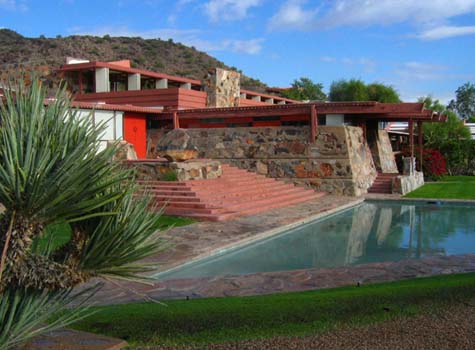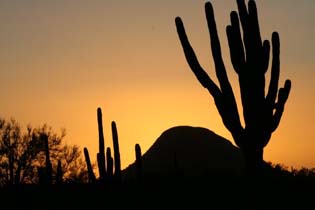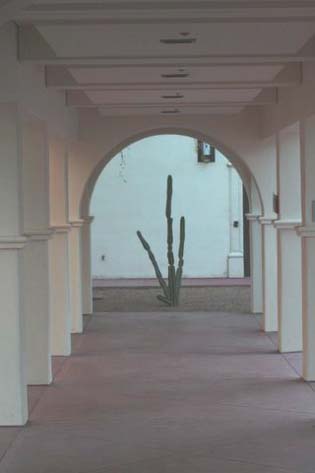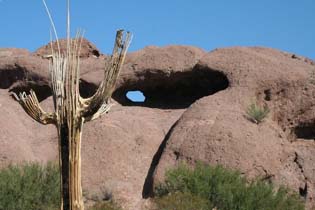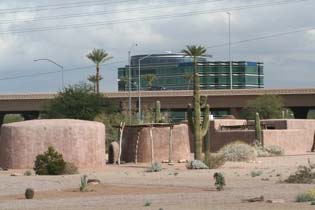Escapees from the monochrome bleariness of
a Canadian winter, my wife and I were vacationing in the Phoenix
area, happily immersed in delicious warmth, revelling in the exotic
sights of pale green saguaro cacti, red flowers contrasting against
the light browns of the desert and dark green fronds of palm trees
soaring high into a deep blue sky. We were not alone, for hordes
of visitors, snowbirds especially, are drawn to Arizona by a fascinating
desert landscape and endless days of sunshine.
From Pueblo Grande we drove miles toward
the northeast, lured by Taliesin West, the masterpiece winter home
and studio for America’s most famous architect, Frank Lloyd
Wright, who lived and worked here from 1937 to 1959.
The rambling, low-slung house dramatically
captures the soul of the surrounding desert with its low horizontal
lines melding into the brow of a hill. Ingeniously designed to offer
spectacular views from almost every nook, it required a lengthy
stroll to appreciate the sprawling magnitude of the place, which
includes accommodations for architects, a theatre, dining room,
a drafting studio and library.
We were captivated by the bold and imaginative
use of canvas, natural materials, Chinese terra-cotta decorations
and even a fire-breathing, wrought-iron dragon. But Wright would
have been disappointed, for today his views of the landscape are
marred by a power line, roads, and the tentacles of encroaching
suburbia.
Phoenix, as we were fast learning, is a city
that knows no restraint. This is non-stop urbanization and its lifestyle
does not match the austerity of the desert landscape. Instead, it
is lavish and opulent reflecting North America’s consumer-oriented
high standard of living and materialism. The automobile dominates
and shimmering multi-lane roadways run everywhere in the sprawling
city. There is no effective public transport. The absurdly over-sized
Hummer is a common sight. On many days a stagnant smog hangs over
the city like a shroud.
Another lengthy car journey delivered us
to the Desert Botanical Gardens, where we learned how life has adapted,
often in bizarre ways, to the harsh desert environment. A guide
explained that the saguaro cactus — known as the monarch of
the Sonoran Desert, for it only grows here — has a shallow
but extensive root system that can quickly draw in rain water. Its
pleated stem can expand and hold up to a ton of water. In spite
of the difficult conditions saguaros live for over 200 years, reaching
heights of 16 metres. I could only imagine what they might do in
a rainy climate.
The barrel cactus, in contrast, is short
and stocky, sports no arms and is often crowned by yellow flowers.
Because it grows faster on the shady side, it always leans toward
the south, earning itself the name, compass cactus — a handy
fact I filed away in case I should ever lose my bearings in some
remote area of the Sonoran desert.
Noticing a small bird peeking out of a hole
in a cactus, the guide explained the hollows are drilled by Gila
woodpeckers seeking food. They then become nesting cavities for
cactus wrens, elf owls, and other birds. Hummingbirds are also abundant,
and once we saw a roadrunner, cartoon-like, race across the road.
Many of the desert plants are used by locals
in ingenious ways. Mesquite molasses on hot cakes sounded tasty,
but I was not about to try rattlesnake hash. Later, my wife luxuriated
at a spa with an aloe rehydration, a jojoba-seeds/juniper/sage moisturizer
and an adobe-clay exfoliation.
On the drive back to our hotel with the sun
glistening on the dry brown hills to the west, the thought occurred
to me that this barren, basically inhospitable (for humans) desert
landscape would inhibit settlement on the part of our species. Instead,
this area has always been a magnet for humans and, enticed by abundant
sunshine and wide-open spaces, the attraction continues unabated
today with politicians vociferously pushing for further growth.
It also occurred to me that even in this vast desert ecosystem there
must be limits. And, as I discovered, some of those limits have
already been surpassed.
Water, vital to making life in the desert
possible, is very scarce; and yet it is consumed by the human population
here so voraciously that the natural water table in some areas has
dropped by 200 feet.
And even more disturbing is the fact that
water piped to the Phoenix ares from the Colorado River to the north
has reduced its once-mighty flow so dramatically that this legendary
river's waters often do not reach the Pacific.
The demand for energy, much of it generated
from burning coal, is also extremely high. Amazingly, Phoenix’s
leaders preach little restraint or conservation. A chill ran through
me when I learned there was no recycling at our resort nor in the
surrounding residential areas.
Over the following days we immersed ourselves
in the rich cultural life of Sun Valley, as the Phoenix area is
called. We enjoyed displays of native culture and arts at the Heard
Museum, an elegant Spanish-style complex built around a cool courtyard.
We went on tours of art galleries, and my wife enjoyed shopping.
Phoenix is not marred by tacky neon strips,
instead shops are collected together in enormous malls offering
an almost unlimited selection of restaurants, galleries and, of
course, shops and more shops. Kierland Commons in Scottsdale, for
example, has a pleasant “main street” ambiance and a
central plaza and fountain that drew us in and made it easy to spend
hours wandering about; and momentarily oblivious to the real landscape
outside.
A hiking aficionado, I found no shortage
of trails. Camelback Mountain and Hole-in-the-Rock parks offer many
delightful walks and because they are located in the centre of the
city, they are easily accessible.
